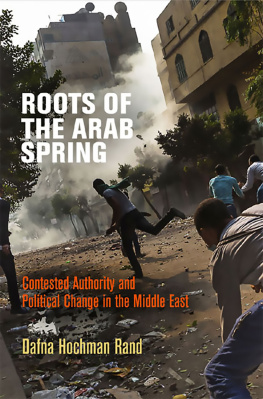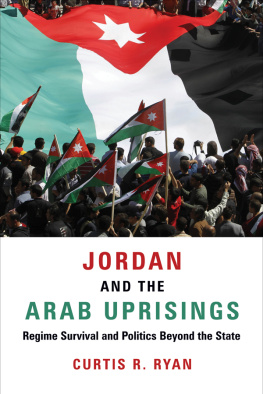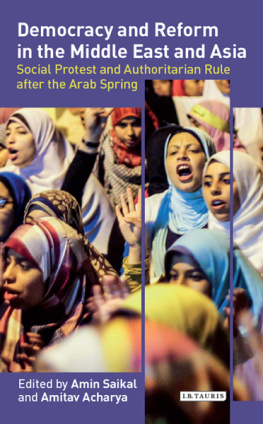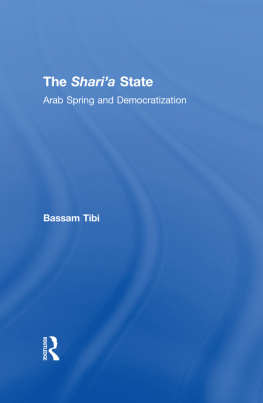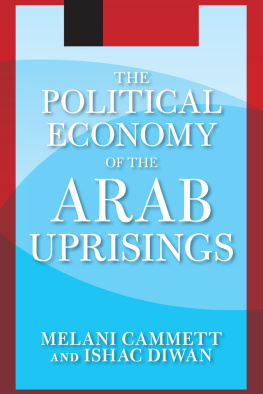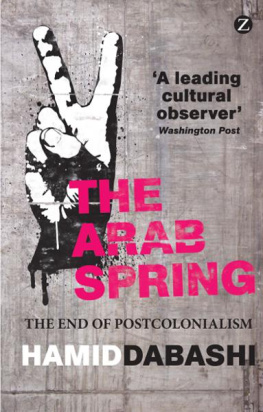The ideas expressed in this book do not reflect the views of the Department of State, the National Security Staff, or the United States government.
Copyright 2013 University of Pennsylvania Press
All rights reserved. Except for brief quotations used for purposes of review or scholarly citation, none of this book may be reproduced in any form by any means without written permission from the publisher.
Published by
University of Pennsylvania Press
Philadelphia, Pennsylvania 19104-4112
www.upenn.edu/pennpress
Printed in the United States of America
on acid-free paper
10 9 8 7 6 5 4 3 2 1
Library of Congress Cataloging-in-Publication Data
ISBN 978-0-8122-4530-1
Preface
In the mid-2000s, I lived in Morocco, Tunisia, and Bahrain, conducting research on the political strategies enabling authoritarian governments to persist in the Middle East and North Africa.
After conducting over a hundred interviews in these three countries, sitting in on parliamentary sessions, and participating in civil society and political activities, my search for a generalizable explanation for the democracy deficit in the region seemed beside the point. Though there were constitutional, bureaucratic, and socioeconomic explanations for authoritarian endurance, this endurance did not appear to be the most apparent trend in the region. On the ground, from the Casbah of Rabat, Morocco, to the ports of Bahrain, the most remarkable characteristic of the regions politics during the first decade of the twenty-first century was its widespread dynamism, including a pervasive uncertainty about the future of both regional and local politics.
Of course, the authoritarian state appeared just as strong as I had expected. Internal security services, including, in some places, despised secret police, exercised powerful oversight roles, often interfering in daily life. Political opposition activists traded storiessome real, some imaginedof arbitrary detentions and deplorable prison conditions. The rulers commanded a pervasive physical presence, with pictures of leaders adorning everything from public buses to hotel lobbies, reminding the citizens of the established political order. Yet in Morocco I also found journalists and womens rights activists trying to push the monarchys limits. These groups and individuals were seizing upon the relatively permissive atmosphere under a new king to publish daring and critical newspaper articles, to mobilize protests in front of parliament, and to advocate for minority and human rights. In Bahrain, I saw a political opposition deeply divided, and a public growing increasingly disillusioned with a new king whom most had expected would be a reformer. In Tunisia, the public was increasingly fed up with the methodical efforts by the president and his cronies to transform a once moderate, pluralistic state into one of the most closed political systems in the world.
Thus, my field research suggested that the autocrats in the region were not at all uniformly robust, as described at the time by Middle East and North Africa experts. While it was true that many of these leaders had ruled for decades, and had successfully overcome intense public opposition and intermittent crises, by the twenty-first century, most were nervously trying to manage the varied political changes occurring around them. Some were doing so more successfully than others. Often, economic, social, or political reforms could appeal to popular and elite allies, minimally allay opposition or civil society demands, and solidify the autocrats rule by building credibility or by co-opting opposition groups. In the short term, these strategic efforts seemed to be working: The autocrats appeared in some cases to be cleverly staying one step ahead of the changing political pressures surrounding themwhether by revising press codes to rein in the expanding media space or by revising constitutions to carefully limit the electoral participation of political challengers. But their ability to stay a step ahead of the game was precarious at best. It seemed apparent that top-down efforts to manage the changing dynamics could easily go awry, and could generate unknown and unintended consequences.
My field research found a degree of flux at odds with the widespread conclusions reached by academics studying the Middle East and North Africa at the time, as well as the consensus among policy makers working on the region.
Many scholars subscribed to what was loosely dubbed the authoritarian resilience research agendaoffering a set of hypotheses to explain how the regions autocrats used economic, institutional, and electoral strategies to wield power, typically by outwitting and outmaneuvering other actors, including the international community and political opposition.
By emphasizing how and why the regions regimes were so extraordinarily successful at staying in power, however, this research agenda often painted, with broad brush strokes, a picture of a stagnant region.
In Washington during this time period, U.S. policy makers began advocating for a Freedom Agenda in the Middle East and North Africa. They turned their attentionat least temporarilyto the promotion of democracy and human rights in a region where both were flagging, in addition to new trade and investment programs. New U.S. government funds focused
The logic of the U.S. Freedom Agenda began with the assumption that the states in the region were durable and strong, with the leadership firmly entrenched. The policy makers who championed this agenda often overlooked the local movements and organizations that were advocating for change, many of which had existed for decades. They discounted, like many academics, the potential for collective action by the regions citizens. Policy makers interested in promoting democratization in the region were also particularly interested in national-level elections, and to some extent they failed to imagine how political change might come about any other way. This failure of imagination meant that policy makers paid less attention to the non-electoral spheres of political society. Focused on promoting freer and fairer elections, many policy makers did not adequately consider other sources of political change, including the potential for cross-cutting revolutionary movements.
Although many policy makers were committed to the principles behind the Freedom Agenda, particularly during its first few years, in practice U.S. efforts had mixed results. Many people in the region rejected the U.S. foreign policy approach to the region postSeptember 11, 2001, particularly the 2003 Iraq War, and these policies tainted the Freedom Agenda. U.S. democracy-promotion strategies also failed to differentiate between those tactics appropriate for the stable authoritarian regimes of the region and those more suited for the unstable, ethnically divided, and conflict-ridden states, such as Iraq and Lebanon. Finally, when elections in Egypt, Palestine, and Lebanon in 20052006 yielded victors considered inimical to U.S. interests, policy makers enthusiasm for democratization in the region withered.

